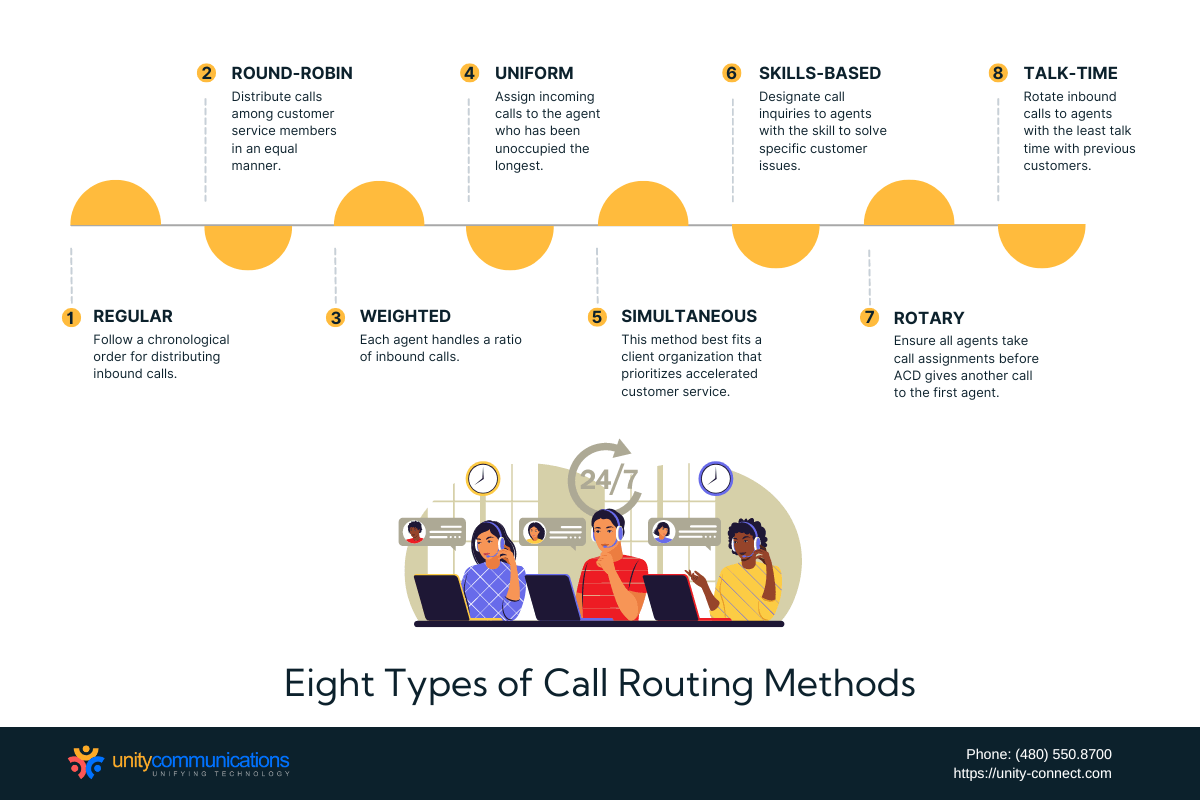Table of Contents
Even as companies strive to keep up with the competition, they must fulfill consumer demands. Customers want quick support via phone calls. Otherwise, frustrated customers can flood businesses with negative feedback and low ratings.
Businesses thus rely on third-party contact centers to increase and improve voice-based customer service. These hubs leverage contact center as a service (CCaaS) to automate call responses. Such a capability helps ensure improved customer satisfaction.
This article explains how call routing works as a contact center feature. It also details the different approaches to distributing inbound calls among the best support agents available.
Call Routing: A Cloud-based Contact Center Feature

Small, mid-sized, and large enterprises tap into cloud-based contact centers to handle numerous customer inquiries. In particular, these customer support hubs address questions and provide resolutions regarding product specifications and issues. They deliver inbound customer service using such communication platforms as:
- Voice calls. Consumers communicate with agents through mobile devices and telephones.
- Live chat. A pop-up chat window is available on websites for real-time engagement.
- Email. Customers send long-form complaints related to their purchases.
- Text messaging. Short electronic inquiries are helpful if internet service is unavailable.
- Social media. Social networks such as Facebook and Instagram connect customers to agents.
- Video calls. Customers and agents interact through live audio-visual calls.
Responding to consumers through these channels is the first step, but ensuring customer satisfaction is insufficient. Quick and efficient customer service is crucial because over 60% of customers will leave after one bad experience, according to the 2023 Zendesk report. Thus, CCaaS solutions must prioritize speed and personalization in customer interactions.
Service providers are adding AI and automation to CCaaS to meet demand. Digital channels are growing, but phone calls are still important. The McKinsey report shows that retail and consumer goods companies invest heavily in automation technologies, demonstrating the continued relevance of traditional communication methods in a technologically changing world.
CCaaS offers a solution to retain speed and personalization when managing massive customer calls. The call routing feature, also known as automatic call distribution (ACD), automatically queues incoming calls and assigns them to agents capable of providing the best responses. ACD follows rules according to predefined attributes, such as the ones below.
- Time of day. Determine the time zone of callers and contact centers.
- Caller identification. Extract information, such as the caller’s location, from phone numbers.
- Language preference. Identify a customer’s default language using speech recognition.
- Auto-attendant selection. Collect input from the caller through an auto-attendant menu.
- Agent skill. Distribute call inquiries based on agent profiles and skills.
Three Ways to Route A Call
The voice-over-internet protocol (VoIP) service uses different key data types to choose where to route calls for the best possible result. It ensures customers receive appropriate resolutions to their product issues and concerns. Before starting, let’s learn more about how this service works.
- Qualifying phase. Incoming calls are transmitted to an interactive voice response (IVR) tool. This AI-powered telephone system allows customers to provide and access data without a live agent. IVR identifies the caller’s purpose through an automated question-and-answer process.
- Call queueing phase. The caller’s responses are then forwarded to ACD for queueing. The tool puts inbound calls on a waitlist to match them with agents. Priority depends on the established routing rules.
- Call distribution phase. Queries and specific customer concerns are routed to the most appropriate agents. Similar to the second step, call distribution adheres to predefined criteria.
Eight Types of Call Routing Methods

A full-featured CCaaS solution includes multiple ACD methods to fine-tune incoming call queueing and routing. The following approaches help companies provide an unmatched customer experience.
- Regular. Follow a chronological order for distributing inbound calls. For example, if contact centers have seven agents but two are absent, the third one will automatically receive the call.
- Round-robin. Distribute calls among customer service members in an equal manner. In short, the second agent takes the next call after the first one succeeds.
- Weighted. Each agent handles a ratio of inbound calls. This method is practical to onboard new employees or slant calls toward high performers. For instance, contact centers receive 50 calls and have two agents available. They have a 50% weighted call distribution, taking 25 calls apiece.
- Uniform. Assign incoming calls to the agent who has been unoccupied the longest. After accepting a call, the agent returns to the waiting line until he’s the most available to answer a call again.
- Simultaneous. Ring all agents’ phones at the same time. The first customer service representative (CSR) to answer the call responds to the query. This method best fits a client organization that prioritizes accelerated customer service.
- Skills-based. Designate call inquiries to agents with the skill to solve specific customer issues. The approach involves aligning a problem’s difficulty with the agents’ proficiency level. It ensures customers receive practical and fast resolutions.
- Rotary. Ensure all agents take call assignments before ACD gives another call to the first agent. If contact centers consist of 20 agents, they must receive incoming calls. The first CSR accepts calls afterward.
- Talk-time. Rotate inbound calls to agents with the least talk time with previous customers.
Benefits of Call Routing

Efficient call distribution offers many advantages to businesses, customers, and employees. By incorporating AI and automation, ACD speeds up responses to consumer inquiries and streamlines in-house operations. Explore how this CCaaS solution helps achieve buyer satisfaction and continued business growth.
Improved Customer Experience
Making consumers happy is the primary goal of every business. Aside from providing innovative products and services, companies must also deliver superb customer service. An intelligent phone management system helps a company retain brand loyalty by providing the benefits below.
- Personalized support. ACD personalizes voice support by assigning customers to agents capable of addressing concerns quickly and effectively. The designated agents have prior knowledge and experience on issues assigned to them. Therefore, they understand what consumers need and respond accordingly.
- Reduced call waiting. The VoIP phone service automates the queueing and distribution of incoming customer calls. Hence, consumers seeking support no longer experience delays or prolonged wait times.
- Accelerated resolution. AI and automation allow inquiries sent via calls to reach agents rapidly. As a result, they can resolve customer issues immediately and effectively.
Enhanced Workforce Management
Consumers are not the only beneficiaries of call routing. Customer service teams also experience the following advantages of this CCaaS feature:.
- Increased productivity. ACD automatically sorts and organizes repetitive call assignments. Thus, agents can focus on providing customers with effective solutions to their problems. Because they already know how to approach the issues assigned to them, CSRs can address them quickly and switch to other tasks seamlessly.
- Balanced workloads. The automated process of routing inbound calls ensures equal task distribution among agents. This strategy makes their workloads more balanced, avoiding overwork and burnout.
- Improved performance. Skills-based distribution is another critical benefit of the contact center management solution. It assigns agents to issues requiring skills they already possess. Hence, they can address customer inquiries faster and more efficiently.
Cost-effective Contact Center
The benefits of call routing are not limited to customers and agents. It also contributes to the overall success of companies. Here are some notable advantages they receive from implementing this cloud-based service:.
- Save on costs. Because ACD automates call queueing and distribution, companies no longer have to hire a separate customer service team to handle such processes. They also do not need physical equipment because the solution runs on the CCaaS platform. This reduces their labor, infrastructure, and real estate costs.
- Prioritize core initiatives. The contact center tool manages the time-consuming, repetitive task of routing incoming calls. Thus, agents can prioritize responding to complex customer problems. ACD also allows other business units to focus on improving the company’s products and services.
- Strengthen a loyal customer base. According to Zendesk, consumers want quick, easy, and effective service. They are willing to switch brands if they don’t get it. Call routing helps businesses keep their customers loyal by ensuring they receive fast and efficient responses to their inquiries.
Knowing the benefits of ACD enables companies to set their expectations and plan an outsourcing strategy. These insights also guide them in aligning their investment plans with their business needs. But to maximize those advantages, here are some tips for setting up a cloud-based phone system.
- Conduct research on target customers to identify their usual concerns and needs.
- Select the appropriate ACD method according to the team and customer base size.
- Keep pre-recorded IVR prompts short but concise.
- Integrate the routing system with customer relationship management (CRM) software.
- Be transparent with the estimated wait time.
- Provide callers with queue position updates and automated callback options.
- Streamline the ability to connect with a live agent if needed.
- Make caller responses color-coded or use tags.
- Offer language-based routing options.
- Execute automated customer surveys for performance evaluation and reporting.
- Record calls to monitor and review recurring issues and inefficiencies.
The Bottom Line
Companies of all sizes need an automated approach to handle large volumes of incoming calls. They must meet customers’ demand for prompt and personalized support to ensure customer satisfaction and retention, resulting in continued business expansion.
Contact center providers help deliver a superb customer experience by optimizing CCaaS. This cloud-based contact center software includes a call routing system that provides fast and effective customer service. Knowing how the phone service works helps verify investment decisions and realize benefits.
Do you want to upgrade your voice support operations? Unity Communications has something innovative to offer you. The award-winning service provider delivers a reliable, cost-efficient cloud contact center solution to boost your inbound support.




